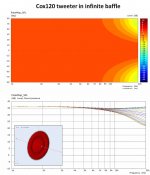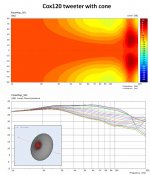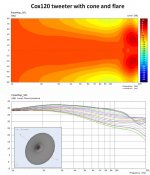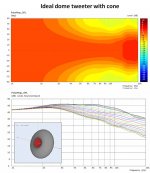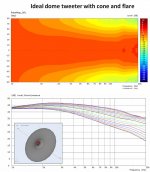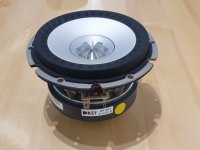Objective 1: Controlled directivity
When I think of this in a coaxial-like arrangement, I think of all the problems most coaxials have
..and then think of a Unity design.
Thanks for reminding about that Sica. There's a project with some data on a German forum.Yes, 120 seems to have details right - tweeter sits nicely and cone edge/surround is pretty smooth. Response gets ragged around 3-6kHz but much better than rivals.
Coaxial speaker Kartesian Cox120_vHP, 8 ohm, 120 mm
SEAS L12 Boutique Haut-parleurs & Audio DIY
Sica 5.5 Boutique Haut-parleurs & Audio DIY response looks pretty good actually!
Neue-Interessante-Sica-5-5-und-6-5-Zoll-Coaxe-mit-Kalotten-HT
Great! I didn't realise that Q100 is still for sale in Europe. Thanks for the tip! And yes, the R100 driver would be quite ideal for this project.You can still get Kef Q100 which has better drivers.
Look here https://www.idealo.de/preisvergleich/MainSearchProductCategory.html?q=kef+q100
I got a cheap pair of Kef R100 for 300$ of the danish "Ebay". So that's a possibility too.
They sound nice by themselves but I guess that an 8" or 10" driver in a closed cabinet would add some punch.
The driver from KEF R300 is even better www.audioexcite.com >> Concentric Three – M5
It's interesting that you mentioned Kef SP1588. That's the 6.5" model, right? People seem to prefer Q100 (5.25") over Q300 (6.5")
Simply because I could not find the raw driver of the other Q*00 or Q*50 models (I even don't know the part number).
I have no idea about individual KEF drivers because I've never measured them, but generally speaking, they are doing a pretty damn good job in recent products.
I suppose I should not judge those drivers based on how well they happen the perform in such low-cost product with super simple crossovers etc.
Indeed, as the final product, Q100 (5.25") does not have good directivity but it was mainly caused by poorly aligned crossover I think, and Q900 (8") was reasonably good, I could not find a good quality measurement of Q300-700 (6.5") but among them, looks rather promising.
And of course, I do not like Q*50's stamper steel frame but not for the sound quality issue, the way it looks!
Other than that, Q*50 could be a great option as well, I personally would use any of these drivers happily.
Oh, one thing I have to mention was, generally speaking, the KEF driver might not have good capabilities of very high SPL or overload, mid-woofer seems to be relatively fragile, so be gentle.
Last edited:
Thank you for the insight. Yeah, I have seen some horror pictures of Uni-Q driver cones that look like somebody stepped on a muffin cup. But I have no need for high SPL. The excursion of the coaxial cone (mid) should be minimized with by crossing high with the 10" woofer. 100db at 300Hz with the Q100 driver would require excursion of around 0.5 mm.
I did some more ABEC simulations for the Kartesian Cox120 tweeter earlier this week mainly just to confirm the previous observations with more refined mesh. I don't think there's really anything new in these results, mostly just confirms what I have been told already, but I thought to share them anyway.
The Cox120 cone acts as a waveguide for the tweeter, but it's far from ideal (as in most coaxial solutions). The on-axis dip can be corrected a bit with the flare as it's at least partly due to poor termination of the waveguide. However, the flare obviously won't correct problems arising from the tweeter geometry. While the tweeter-cone interface does not not include significant steps or gaps, it's clear that this tweeter geometry is not optimal for loading a waveguide. This is most likely because it just doesn't radiate such nice spherical wavefront as a more ideal spherical cap dome (Genelec, KEF) because the suspension contributes to the radiating structure. Elac Uni-fi appears to have a similar tweeter by the way.
The simulations for the "ideal" spherical cap dome obviously look much better. There's the on-axis dip because of the poor waveguide termination, but that can be nicely corrected by including the flare. The results could probably be further improved by breaking the axisymmetry of the waveguide by adding some ellipticity to the flare. With that and nice rounding for the baffle edges, the end result would look pretty much like the Genelec coax + baffle.
All polars are normalized for the on-axis. Note also that the simulation does not include the breakup of the fabric tweeter!
The Cox120 cone acts as a waveguide for the tweeter, but it's far from ideal (as in most coaxial solutions). The on-axis dip can be corrected a bit with the flare as it's at least partly due to poor termination of the waveguide. However, the flare obviously won't correct problems arising from the tweeter geometry. While the tweeter-cone interface does not not include significant steps or gaps, it's clear that this tweeter geometry is not optimal for loading a waveguide. This is most likely because it just doesn't radiate such nice spherical wavefront as a more ideal spherical cap dome (Genelec, KEF) because the suspension contributes to the radiating structure. Elac Uni-fi appears to have a similar tweeter by the way.
The simulations for the "ideal" spherical cap dome obviously look much better. There's the on-axis dip because of the poor waveguide termination, but that can be nicely corrected by including the flare. The results could probably be further improved by breaking the axisymmetry of the waveguide by adding some ellipticity to the flare. With that and nice rounding for the baffle edges, the end result would look pretty much like the Genelec coax + baffle.
All polars are normalized for the on-axis. Note also that the simulation does not include the breakup of the fabric tweeter!
Attachments
Again:
..perhaps consider a (small) *Unity horn design (with a midbass below it). OR, just go with a bit larger Synergy horn design.
-forum member Patrick Bateman is the only one I know who has tried small Unity & Synergy horns.
*it could even use a dome tweeter instead of compression driver. This type of dome tweeter (with a ring "surround") works well in horns:
Peerless DX25BG60-04 1" Silk Dome Tweeter 4 Ohm
or the non-ferro-fluid from Scan Speak:
ScanSpeak Discovery D2604/833000, 1" Dome Tweeter
..perhaps consider a (small) *Unity horn design (with a midbass below it). OR, just go with a bit larger Synergy horn design.
-forum member Patrick Bateman is the only one I know who has tried small Unity & Synergy horns.
*it could even use a dome tweeter instead of compression driver. This type of dome tweeter (with a ring "surround") works well in horns:
Peerless DX25BG60-04 1" Silk Dome Tweeter 4 Ohm
or the non-ferro-fluid from Scan Speak:
ScanSpeak Discovery D2604/833000, 1" Dome Tweeter
Last edited:
So I probably won't be getting Cox120 drivers, particularly since there's no measured directivity data available.
Well, i don't know of any close to perfect co-axial mid-tweeter drivers. KEF upper class new models seem to work best, but I don't know of "raw" measurements of them. Anyway careful eq and xo settings will help to minimize audible issues and let them do the best they can, and reveal the acoustic benefits in room environment.
Most important thing is to use a woofer, to avoid large excursion of the mid cone. Mid-tweeter integration is rather easy to handle with dsp, and tweeter's on-axis wiggles are compensated by off-axis, giving smooth listening window curve.
An example of how different tweeter models behave in SEAS MR18, onax measured by me in this project SEAS MR18 3-way
Again:
..perhaps consider a (small) *Unity horn design (with a midbass below it). OR, just go with a bit larger Synergy horn design.
-forum member Patrick Bateman is the only one I know who has tried small Unity & Synergy horns.
*it could even use a dome tweeter instead of compression driver. This type of dome tweeter (with a ring "surround") works well in horns:
Peerless DX25BG60-04 1" Silk Dome Tweeter 4 Ohm
or the non-ferro-fluid from Scan Speak:
ScanSpeak Discovery D2604/833000, 1" Dome Tweeter
Sorry Scott. I seem to have missed year earlier massage in this thread. Synergy or Unity horn is an interesting alternative. Unfortunately, I haven't had a chance the hear them, and nor do I know enough about them to know their strengths and weaknesses. I should probably study this topic too.
Well, i don't know of any close to perfect co-axial mid-tweeter drivers. KEF upper class new models seem to work best, but I don't know of "raw" measurements of them. Anyway careful eq and xo settings will help to minimize audible issues and let them do the best they can, and reveal the acoustic benefits in room environment.
Most important thing is to use a woofer, to avoid large excursion of the mid cone. Mid-tweeter integration is rather easy to handle with dsp, and tweeter's on-axis wiggles are compensated by off-axis, giving smooth listening window curve.
An example of how different tweeter models behave in SEAS MR18, onax measured by me in this project SEAS MR18 3-way
Yeah but at this point I judge that I can do better with KEF Qx00 or Qx50 drivers than Cox120. The latter has the advantage of making it easier to integrate the cone edge to the flare, but it think UniQ is a better choice overall.
As for the mid dome excursion, a 5.25" UniQ (Sd=75 cm^2) would be better than Cox120 (47.8 cm^2) also in that respect.
Why not keep the conversation public as you may not be the only one interested in such a configuration.Yeah, I'm a bit tempted to replace my daughter's MR183w coaxials with either KEF or Tangband - mainly because of esthetics. That's why I'm so interested in your project! You are wellcome to visit me in Jyväskylä as well! PM for contact info
I have Q100's on my home desktop and have thought about adding an Anarchy woofer in a sealed .5cf chamber with the Q coax up top. For low end and aesthetics I'd rather use a L26ROY, but I'm not sure my desk legs would be too happy. [emoji28]
^ For sure I'll keep posting if I move on! This kind of tweaking would be a nice winter indoor project...
W6-2313 - 6.5” Paper Coaxial Full Range - TB SPEAKER CO., LTD.
www.audioexcite.com >> Concentric Three – M5
W6-2313 - 6.5” Paper Coaxial Full Range - TB SPEAKER CO., LTD.
www.audioexcite.com >> Concentric Three – M5
Why not keep the conversation public as you may not be the only one interested in such a configuration.
Sure thing
Good looking driver.
Still, I don't think your are going to get much controlled directivity with the driver (above about 2.5 kHz it will be modestly directive).
To get a low diffraction signature either have a large baffle (moving diffraction much lower in freq. to keep it out of the >800 Hz range) OR consider a large sphere (for a more uniform profile).
Still, I don't think your are going to get much controlled directivity with the driver (above about 2.5 kHz it will be modestly directive).
To get a low diffraction signature either have a large baffle (moving diffraction much lower in freq. to keep it out of the >800 Hz range) OR consider a large sphere (for a more uniform profile).
Last edited:
Seas L12RE/XFC desing and crossover from Seas/Madisound:http://www.madisound.com/pdf/L12RE_XFC_AppNote.pdf
There is a commercial 2-way that uses this driver and got rave reviews in Stereophile:
Trenner & Friedl Sun loudspeaker | Stereophile.com
There is a commercial 2-way that uses this driver and got rave reviews in Stereophile:
Trenner & Friedl Sun loudspeaker | Stereophile.com
- Home
- Loudspeakers
- Multi-Way
- 3-way active standmounts with coax upper end & Other UniQ adventures
